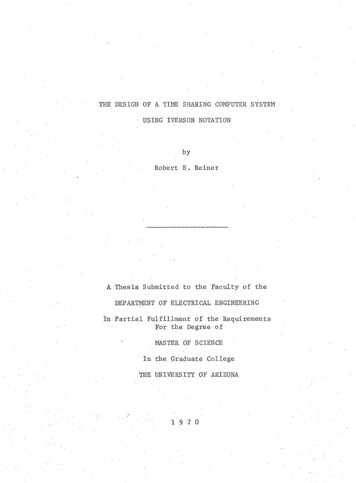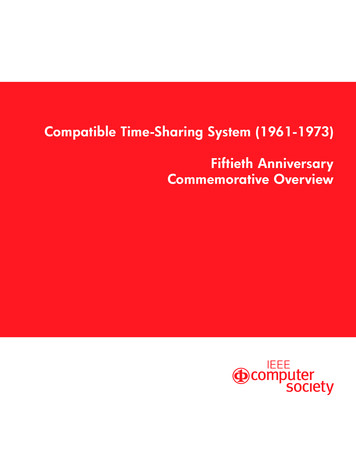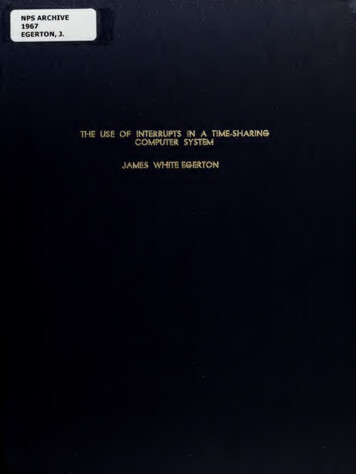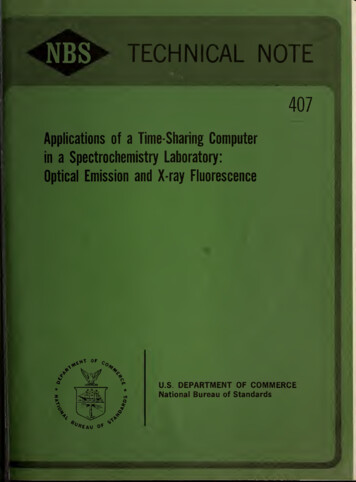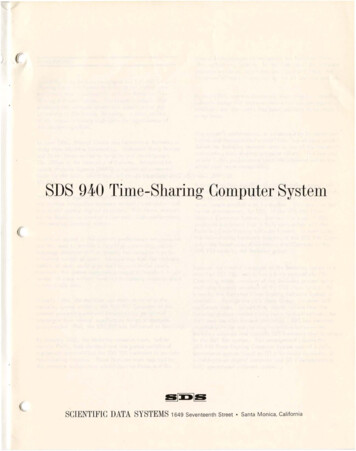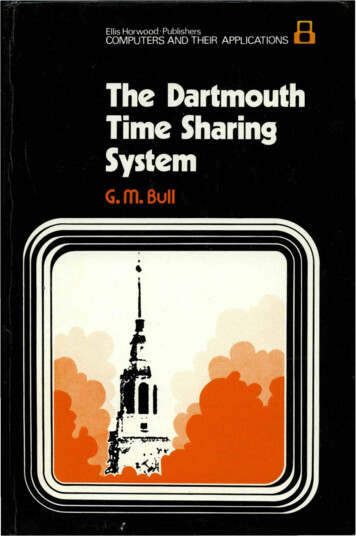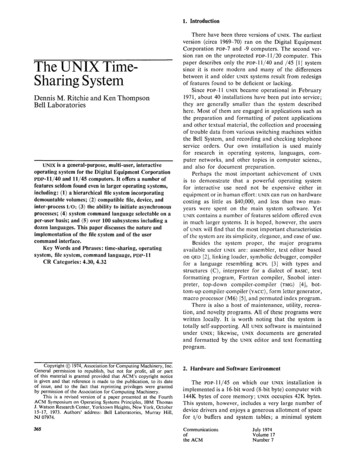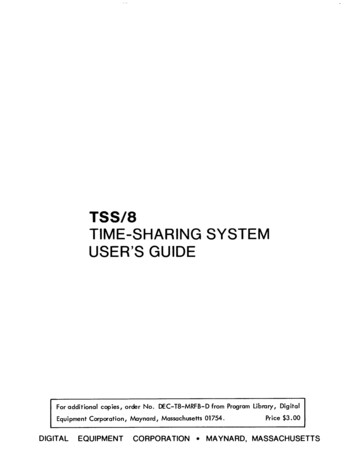
Transcription
Time-Sharing Computer Systemwith Audio IntegrationFinal ReportApril 28, 2010Sponsored by:ECE 480Team 4ManagerWebmasterDocument PrepPresentation PrepLab CoordinatorDavid WilsonTim HaynieAndy BruinsmaBret CharboneauBilly Mattingly
Executive SummaryTwo schools near Arusha, Tanzania currently have multi-seat computersystems that require upgrades. A third school is also scheduled to be added tothis project. Michigan State University, along with support from George andVickie Rock and the Dow Chemical Company, will continue to support thisproject in May 2010. The two currently operational systems have six sessionsrunning off of a single computer in order to save on both hardware and powercosts. These systems require manual input to associate each screen with theproper keyboard and mouse and can be executed incorrectly by students withlimited computer experience. The system also periodically crashes when not allof the sessions are in use. It is the responsibility of Design Team 4 toimplement a system that assists in associating a keyboard, mouse and monitorto each user station. Team 4 will also bring the third school online when theytravel to Arusha in May 2010. In addition, Team 4 will implement audiocapabilities to each station to further the educational opportunities for thestudents.1
AcknowledgementDesign Team 4 would like to thank all of those responsible in makingthis incredible project possible. First and foremost, a special thanks to Georgeand Vickie Rock and the Dow Chemical company for their generous support.We would also like thank Michigan State University and Dr. Erik Goodman inallowing the team to travel to Tanzania and implement the project.This project was also successful because of previous design teammembers Dan Newport and Josh Wong. Their insight into installing andmaintaining MDM was invaluable to the team’s success.Also, the team would like to thank Gregg Mulder and Roxanne Peacock ofthe ECE department for their support and patience in ensuring the team washelped whenever needed.Last but not least, the team would like to thank Dr. Mukkamala, DesignTeam 4’s facilitator, for his weekly insight, support, and dedication to theteam’s success.2
Table of ContentsChapter 1. 4Introduction. 4Background . 5Chapter 2. 6House of Quality . 7Design Options. 9Design Decision . 10Solution Matrices . 11Chapter 3. 12Multiseat Display Manager. 12Sound Implementation . 16USB Devices. 17Hardware Solution . 18Chapter 4. 28Final Product. 28Results. 30Chapter 5. 31Cost Analysis . 31Gantt Chart. 32Conclusion . 37Appendix I . 38Technical Roles. 38Appendix II . 45References. 45Appendix III. 46MDM Configuration Files . 46Microcontroller Source Code. 683
Chapter 1IntroductionIn Tanzania, the availability of educational resources is very scarce whichleaves many students limited access to gain knowledge. The students there donot have access to a library and normal computer systems are too expensive forthem to be readily available. However, a low-cost solution to provide studentswith internet access would help solve the problem at hand.Two teams have successfully implemented a solution that is still in useat two schools near Arusha, Tanzania. At both schools, the currentconfiguration is a multi-seat computer system that is able to produce six usersessions off of just one computer. This semester, Michigan State University willsend another team to Tanzania to setup a third school with a six-user system,as well as provide upgrades to the schools already online. Funding of thisproject is now being sponsored by George and Vickie Rock, as well as the DOWChemical Company.By reviewing progress of previous teams, this semester’s team shouldstrive to revise the current setup in order to add the required upgrades. In orderto have a successful design, the team’s goals and criteria are as follows: Provide a design that is low-cost relative to commercial solutions. If thisdesign is ever widely implemented, it is important that as many schoolsas possible can gain the opportunity to have a multi-seat system. The system should assist students in associating all keyboards and miceto each individual seat.4
Create a design that is capable of having sound output at each seatwhich will also be properly associated. This is a requested upgrade toimprove learning experience of Tanzanian students. Ensure that the design is user-friendly for teachers and students. Build a system that is of low maintenance due to the infrequent, on-sitesupport of MSU design teams.BackgroundIn the fall semester of 2008, the Lenovo Corporation made the decision toprovide an opportunity for ECE 480 students. The students would be able todesign a product for underdeveloped Tanzanian schools. The task is to providelow cost, low power usage, and low maintenance solar powered multi-usercomputers. This system would be designed to overcome the schools’ lack ofelectricity and telecommunication systems, the harsh climate, and the students’lack of computer experience.In previous semesters, two design teams have dedicated their time toprovide the requested computers for the Tanzanian schools. The first teamsuccessfully designed a system that is powered by solar energy, using solarpanels that charge a battery bank. In addition, the team was able to construct amanagement system that monitors voltages and currents coming from the solarpanels and the battery. Also, the system was designed to monitor thetemperature in the battery case. If the temperature exceeded the safetemperature, the system will automatically shut down.The second team had a similar task as they were to design a multi-usercomputer system that would be implemented in a second Tanzanian school.5
Additionally, the team successfully installed modified antennas on two routers,one at each school. The antennas allow a satellite router to be accessed fromone school to another, approximately two miles apart. Originally, the satelliterouter was installed at the first school where there is not access to the powergrid. The second team decided to move the satellite to the secondary schoollocated on the power grid in order to relieve power usage from the solar panelsat the first school.Chapter 2FAST DiagramIn order to maintain focus on the needs of the customer, Design Team 4used a FAST diagram to aid them throughout the design process. The principlereason for the project’s design is to educate Tanzanian students by providinginternet access. From the diagram (figure 1), one can see exactly what thecustomer needs are: accommodate user by adding sound, reducing cost,removing system bugs, and displaying seat registration instructions.6
Figure 1. FAST DiagramHouse of QualityTeam 4 used The House of Quality Matrix (figure 2) to determine theCustomer Critical Requirements (CCRs) and implement the System DesignSpecifications. This matrix was used in the team’s decision making process andto help reduce design uncertainties. The overall goal for the team was to ensurecustomer satisfaction and that the voice of customer was being consideredthroughout the design process. Also, Team 4 used the matrix to compare thedesign performance to the competitor’s design. In the matrix it is noticeablethat Team 4’s design is more cost efficient than the competitor. The House ofQuality Matrix shows that the customer’s most important need is to haveinternet access on a multi-user system and minimize seat registration errors.7
Figure 2. House of Quality8
Design OptionsFor the design portion of this project, the team had two main options toconsider.1. Commercial Hardware and SoftwareUserful – One possible solution to the customer needs comes mainly in theform of a commercially available product from a company called Userful.This company sells and distributes both the software (Userful Desktop) andhardware (Userful Multiplier) necessary for multi-seat capabilities. TheMultiplier product allows each user to connect a USB keyboard, a USBmouse, a pair of speakers or headphones, a microphone, and a USBperipheral to his or her seat through the Multiplier. The main disadvantageof Userful is cost. The price ranges from 69-99 per seat according to theirwebsite.2. Modified Open-Source Software and Custom HardwareMDM – The other main option is to use a combination of an actual displaymanager (Gnome Display Manager or GDM) in conjunction with additionalsoftware to provide multiple seats. This additional software is calledMultiseat Display Manager (MDM) and was specifically designed to be usedin a multi-seat configuration. The main advantage of MDM is that it wasdesigned for multi-seat use and assigning keyboards and mice to eachsession should be relatively simple. MDM should allow for the expansion ofadding sound to each session. To do so, a USB soundcard will be added andconfigured for each session.9
Hardware – The hardware that would compliment the open-source MDMsoftware would provide an audio interface for each user as well as reduceassociation errors of keyboards and mice. It was designed not only to becompatible with the MDM software, but also in any multi-user environment.The hardware should also make the system as a whole more user friendlyand is advantageous over a commercial solution because it provides a majorreduction in cost per seat. The components that comprise this systemwould include a hub for each user with an audio interface, as well as onecommon communication link between all user hubs. This communicationhub would contain a microcontroller to manage and direct all user inputsfrom their respective hubs.Design DecisionWith cost and quality being the main two concerns, Design Team 4agreed with previous teams that using the open-source software of GDM andMDM is the best option. In addition to the previously used software, the teamalso determined their hardware solution was an acceptable method ofcorrecting USB device association problems. While Userful would be anacceptable choice, Design Team 4 made it a goal to match the effectiveness oftheir product but doing so at a lower cost. Also, because MDM is the currentsystem in place in Tanzania, integration with the currently installed systemsshould be relatively seamless. In addition to the current installation, however,the team will need to implement sound as well as correct issues experienced bythe current schools.10
Solution MatricesDesign Team 4 used the following solution matrices (figures 3 and 4) toaid in design decisions. These matrices helped the team focus on the importantcriterion throughout the design process.Feasibility MatrixFigure 3. Feasibility MatrixSelection MatrixFigure 4. Selection Matrix11
Chapter 3Multiseat Display ManagerSection 1 – Implementation decisionsThe first step in setting up MDM is deciding what distribution of Linuxwill be used. Because MDM is not an actual display manager, rather a wrapperto be used in conjunction with many common distributions, an actual displaymanager needs to be sel
Two schools near Arusha, Tanzania currently have multi-seat computer systems that require upgrades. A third school is also scheduled to be added to this project. Michigan State University, along with support from George and Vickie Rock and the Dow Chemical Company, will continue to support this project in May 2010. The two currently operational systems have six sessions
